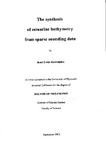The synthesis of estuarine bathymetry from sparse sounding data
| dc.contributor.author | Burroughes, Janet Eirlys | |
| dc.contributor.other | Faculty of Science and Engineering | en_US |
| dc.date.accessioned | 2013-09-19T12:47:50Z | |
| dc.date.available | 2013-09-19T12:47:50Z | |
| dc.date.issued | 2001 | |
| dc.identifier | NOT AVAILABLE | en_US |
| dc.identifier.uri | http://hdl.handle.net/10026.1/1887 | |
| dc.description.abstract |
The two aims of the project involved: 1. Devising a system for prediction o f areas of bathymetric change within the Fal estuary 2. Formulating and evaluating a method for interpolating single beam acoustic bathymetry to avoid artefacts o f interpolation. In order to address these aims, sources of bathymetric data for the Fal estuary were identified as Truro Harbour Office, Cornwall County Council and the Environment Agency. The data collected from these sources included red wavelength Lidar, aerial photography and single beam acoustic bathymetry from a number of different years. These data were input into a Geographic Information System (GIS) and assessed for suitability for the purposes o f data comparison and hence assessment of temporal trends in bathymetry within the estuary Problems encountered during mterpolation of the acoustic bathymetry resulted in the later aim of the project, to formulate an interpolation system suitable for interpolation of the single beam, bathymetric data in a realistic way, avoiding serious artefacts of interpolation. This aim was met, successfully, through the following processes: 1. An interpolation system was developed, using polygonal zones, bounded by channels and coastlines, to prevent interpolation across these boundaries. This system, based on Inverse Distance Weighting (IDW) interpolation, was referred to as Zoned Inverse Distance Weighting (ZIDW). 2. ZIDW was found, by visual inspection, to eliminate the interpolation artefacts described above. 3. The processes of identification of sounding lines and charmels, and the allocation of soundings and output grid cells to polygons, were successfully automated to allow ZIDW to be applied to large and multiple data sets. Manual intervention was maintained for processes performed most successfully by the human brain to optimise the results o f ZIDW. 4. To formalise the theory of ZIDW it was applied to a range of idealised, mathematically defined chaimels. For simple straight and regular curved, mathematical channels interpolation by the standard TIN method was found to perform as well as ZIDW. 5. Investigation of sinusoidal channels within a rectangular estuary, however, revealed that the TIN method begins to produce serious interpolation artefacts where sounding lines are not parallel to the centre lines o f channels and ridges. Hence, overall ZIDW was determined mathematically to represent the optimum method o f interpolation for single beam, bathymelric data. 6. Finally, ZIDW was refined, using data from the Humber and Gironde estuaries, to achieve universal applicability for interpolation of single beam, echo soimding data from any estuary. 7. The refinements involved allowance for non-continuous, flood and ebb type charmels; consideration of the effects of the scale of the estuary; smoothing of the channels using cubic splines; interpolation using a 'smart' ellipse and the option to reconstruct sounding lines from data that had previously been re-ordered. | en_US |
| dc.language.iso | en | en_US |
| dc.publisher | University of Plymouth | en_US |
| dc.title | The synthesis of estuarine bathymetry from sparse sounding data | en_US |
| dc.type | Thesis | en_US |
| plymouth.version | Full version | en_US |
| dc.identifier.doi | http://dx.doi.org/10.24382/1304 |
Files in this item
This item appears in the following Collection(s)
-
01 Research Theses Main Collection
Research Theses Main


